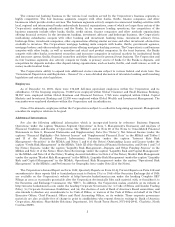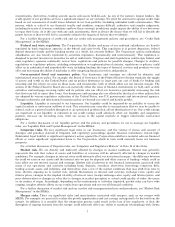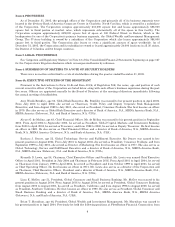Bank of America 2005 Annual Report Download - page 40
Download and view the complete annual report
Please find page 40 of the 2005 Bank of America annual report below. You can navigate through the pages in the report by either clicking on the pages listed below, or by using the keyword search tool below to find specific information within the annual report.significantly undercapitalized and critically undercapitalized) and requires the respective federal regulatory agencies to
implement systems for “prompt corrective action” for insured depository institutions that do not meet minimum capital
requirements within such categories. FDICIA imposes progressively more restrictive constraints on operations,
management and capital distributions, depending on the category in which an institution is classified. Failure to meet
the capital guidelines could also subject a banking institution to capital raising requirements. An “undercapitalized”
bank must develop a capital restoration plan and its parent holding company must guarantee that bank’s compliance
with the plan. The liability of the parent holding company under any such guarantee is limited to the lesser of five
percent of the bank’s assets at the time it became “undercapitalized” or the amount needed to comply with the plan.
Furthermore, in the event of the bankruptcy of the parent holding company, such guarantee would take priority over the
parent’s general unsecured creditors. In addition, FDICIA requires the various regulatory agencies to prescribe certain
non-capital standards for safety and soundness relating generally to operations and management, asset quality and
executive compensation and permits regulatory action against a financial institution that does not meet such standards.
The various regulatory agencies have adopted substantially similar regulations that define the five capital
categories identified by FDICIA, using the total risk-based capital, Tier 1 risk-based capital and leverage capital ratios
as the relevant capital measures. Such regulations establish various degrees of corrective action to be taken when an
institution is considered undercapitalized. Under the regulations, a “well capitalized” institution must have a Tier 1 risk-
based capital ratio of at least six percent, a total risk-based capital ratio of at least ten percent and a leverage ratio of at
least five percent and not be subject to a capital directive order. Under these guidelines, each of the Banks was
considered well capitalized as of December 31, 2005.
Regulators also must take into consideration: (a) concentrations of credit risk; (b) interest rate risk (when the
interest rate sensitivity of an institution’s assets does not match the sensitivity of its liabilities or its off-balance-sheet
position); and (c) risks from non-traditional activities, as well as an institution’s ability to manage those risks, when
determining the adequacy of an institution’s capital. This evaluation will be made as a part of the institution’s regular
safety and soundness examination. In addition, the Corporation, and any Bank with significant trading activity, must
incorporate a measure for market risk in their regulatory capital calculations.
Distributions
The Corporation’s funds for cash distributions to its stockholders are derived from a variety of sources, including
cash and temporary investments. The primary source of such funds, and funds used to pay principal and interest on its
indebtedness, is dividends received from the Banks. Each of the Banks is subject to various regulatory policies and
requirements relating to the payment of dividends, including requirements to maintain capital above regulatory
minimums. The appropriate federal regulatory authority is authorized to determine under certain circumstances
relating to the financial condition of a bank or bank holding company that the payment of dividends would be an unsafe
or unsound practice and to prohibit payment thereof.
In addition, the ability of the Corporation and the Banks to pay dividends may be affected by the various minimum
capital requirements and the capital and non-capital standards established under FDICIA, as described above. The right
of the Corporation, its stockholders and its creditors to participate in any distribution of the assets or earnings of its
subsidiaries is further subject to the prior claims of creditors of the respective subsidiaries.
Source of Strength
According to Federal Reserve Board policy, bank holding companies are expected to act as a source of financial
strength to each subsidiary bank and to commit resources to support each such subsidiary. This support may be required
at times when a bank holding company may not be able to provide such support. Similarly, under the cross-guarantee
provisions of the Federal Deposit Insurance Act, in the event of a loss suffered or anticipated by the FDIC – either as a
result of default of a banking subsidiary or related to FDIC assistance provided to a subsidiary in danger of default – the
other Banks may be assessed for the FDIC’s loss, subject to certain exceptions.
Competition
In 2005, the Corporation had four business segments: Global Consumer and Small Business Banking, Global
Business and Financial Services, Global Capital Markets and Investment Banking, and Global Wealth and Investment
Management. The activities in which the Corporation and its business segments engage are highly competitive.
Generally, the lines of activity and markets served involve competition with other banks, thrifts, credit unions and other
nonbank financial institutions, such as investment banking firms, investment advisory firms, brokerage firms,
investment companies and insurance companies. The Corporation also competes against banks and thrifts owned by
nonregulated diversified corporations and other entities which offer financial services, located both domestically and
internationally and through alternative delivery channels such as the Internet. The methods of competition center
around various factors, such as customer services, interest rates on loans and deposits, lending limits and customer
convenience, such as location of offices.
4
























